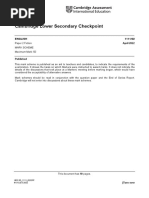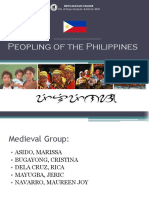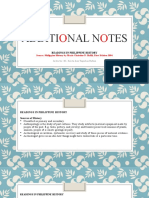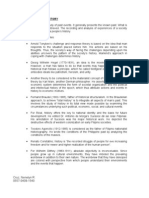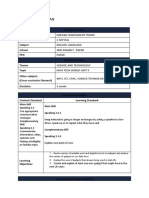0 ratings0% found this document useful (0 votes)
49 viewsGEC 102 Historical Research
GEC 102 Historical Research
Uploaded by
K. U. A.The document summarizes the historical research on the discovery of the Philippines. It discusses that while Magellan was the first European to arrive in 1521, the Philippines had been discovered and inhabited long before by ancient traders and settlers from China, India, the Middle East and surrounding regions, with evidence of contact dating back thousands of years. The earliest evidence of human occupation comes from stone tools used by Homo erectus around 700,000 years ago in Kalinga. Thus, Magellan did not discover the Philippines, which had been inhabited for centuries prior to European contact.
Copyright:
© All Rights Reserved
Available Formats
Download as PPTX, PDF, TXT or read online from Scribd
GEC 102 Historical Research
GEC 102 Historical Research
Uploaded by
K. U. A.0 ratings0% found this document useful (0 votes)
49 views27 pagesThe document summarizes the historical research on the discovery of the Philippines. It discusses that while Magellan was the first European to arrive in 1521, the Philippines had been discovered and inhabited long before by ancient traders and settlers from China, India, the Middle East and surrounding regions, with evidence of contact dating back thousands of years. The earliest evidence of human occupation comes from stone tools used by Homo erectus around 700,000 years ago in Kalinga. Thus, Magellan did not discover the Philippines, which had been inhabited for centuries prior to European contact.
Original Description:
Performance Task on GEC 102 (Readings in Philippine History)
Copyright
© © All Rights Reserved
Available Formats
PPTX, PDF, TXT or read online from Scribd
Share this document
Did you find this document useful?
Is this content inappropriate?
The document summarizes the historical research on the discovery of the Philippines. It discusses that while Magellan was the first European to arrive in 1521, the Philippines had been discovered and inhabited long before by ancient traders and settlers from China, India, the Middle East and surrounding regions, with evidence of contact dating back thousands of years. The earliest evidence of human occupation comes from stone tools used by Homo erectus around 700,000 years ago in Kalinga. Thus, Magellan did not discover the Philippines, which had been inhabited for centuries prior to European contact.
Copyright:
© All Rights Reserved
Available Formats
Download as PPTX, PDF, TXT or read online from Scribd
Download as pptx, pdf, or txt
0 ratings0% found this document useful (0 votes)
49 views27 pagesGEC 102 Historical Research
GEC 102 Historical Research
Uploaded by
K. U. A.The document summarizes the historical research on the discovery of the Philippines. It discusses that while Magellan was the first European to arrive in 1521, the Philippines had been discovered and inhabited long before by ancient traders and settlers from China, India, the Middle East and surrounding regions, with evidence of contact dating back thousands of years. The earliest evidence of human occupation comes from stone tools used by Homo erectus around 700,000 years ago in Kalinga. Thus, Magellan did not discover the Philippines, which had been inhabited for centuries prior to European contact.
Copyright:
© All Rights Reserved
Available Formats
Download as PPTX, PDF, TXT or read online from Scribd
Download as pptx, pdf, or txt
You are on page 1of 27
Historical Research:
The Discovery of the Philippines
Problem
• Did Magellan discover the Philippines? If not, why was
it said that he “discovered” the Philippines?
• If not Magellan, then who discovered the Philippines?
• When was the Philippines discovered?
Hypothesis
Magellan did not discover the Philippines.
The first people to discover the Philippines are actually
traders from China, India, Middle East and the
neighboring countries in the South East Asia.
Discovery happened centuries prior the arrival of
Europeans.
Location of relevant sources
• Library
• Scribd
• The Internet
Summary of information based from
sources
I. Arrival of Magellan
• Ferdinand Magellan and his crew caught sight of and
landed on the Philippine shores in March 1521.
• This was the first recorded sighting of the Philippines by
Europeans.
• Magellan claimed the islands he saw for Charles I of Spain
and named them Islas de San Lazaro.
Summary of information based from
sources
II. Pre-Magellan’s Arrival
• There had been contact between early settlers of the
Philippines and the Hindus, Chinese, Japanese and Arabs
before the 16th century.
Summary of information based from
sources
II. Pre-Magellan’s Arrival - Hindu
• Archeological findings like the image of Siva and clay
medallion with image of Garuda engravings were proof of
connection between Philippines and Hindus.
• Spaniards, upon arrival, found systems of writing
developed from the alphabet then used by Hindu people
at Java that were being used by Filipino people.
Summary of information based from
sources
II. Pre-Magellan’s Arrival - Chinese
• Prior to the coming of Spaniards, trade had already
existed between China and Philippines according to
Chinese scholars Ma Tuan-Li and Chau Ju-Kua.
• The Chinese had the connection in the Philippines even in
the early years during the Tang era (618-906)
• Trade became active during the Sang Dynasty (960-1279),
which greatly flourished during the Yuan (1271-1368) and
Ming (1368-1662) Dynasties.
Summary of information based from
sources
II. Pre-Magellan’s Arrival - Japanese
• At the time of Spain’s early occupation, there were
already active communities of Japanese settlers and
traders in Manila and parts of Northern Luzon.
Summary of information based from
sources
II. Pre-Magellan’s Arrival - Arab
• Prior to arrival of Spaniards, Islam, an Arab influence, was
already extending its influence beyond Maguindanao and
the Sulu Archipelago.
• The Sultanate of Sulu was established in Jolo in1450.
Summary of information based from
sources
II. Pre-Magellan’s Arrival - LCI
• The Laguna Copperplate Inscription, the earliest known
written document found in the Philippines, is written in an
ancient Indonesian script called Kavi.
• The language used was a mixture of Sanskrit, old
Javanese, old Malay and old Tagalog.
Summary of information based from
sources
III. Models of Migration – H. Otley Beyer
• Wave Migration Theory: the first migrants are the “Dawn
Man” who resembled the Java Man, Peking Man and
other Asian Homo sapiens that existed about 250,000
years ago followed by the Negritos who arrived about
30,000 years ago, then the Indonesians and Malays who
came to the islands in boats about 2,000 years ago.
• No archeological or historical evidence to support this
theory.
Summary of information based from
sources
III. Models of Migration – Wilhelm Solheim
• Nusantao Maritime Trading and Communication Network:
People with distant origins from 50,000 years ago in the
area of present-day coastal eastern Vietnam and Southern
China had moved to the area of the Bismarck Islands
south and east of Mindanao and later spread among
seafarers from the area to the rest of Island Southeast
Asia.
Summary of information based from
sources
III. Models of Migration – Peter Bellwood
• Out of Taiwan: the first Austronesians reached the
Philippines at around 2200 BC from Taiwan
Summary of information based from
sources
IV. Archeological Discoveries (Paleolithic)
• Tabon Man (Palawan, 1962) – possibly the oldest Homo
sapiens sapiens fossil evidence in Southeast Asia in the
form of a tibia fragment dating to 47,000 (+/- 11,000)
years ago
• Callao Man (Cagayan, 2007) – a hominin third metatarsal
discovered and dated to 66,700 (+/-1000) years ago. The
unknown hominin was later identified as a new species,
the Homo luzonensis
Summary of information based from
sources
IV. Archeological Discoveries (Paleolithic)
• Cache of butchered rhino bones and dozens of stone tools
are discovered in Kalinga in 2018 which proves that there
has been human occupation in the Philippines more than
700,000 years ago.
• Most likely used by Homo erectus, an archaic human
species that first evolved 2 million years ago and the first
member of our genus to expand out of Africa. Homo
erectus bones have been found in China and Java.
Sources
1. Calilung F.C ., Jaime V.G. (2013) Kamalayan; Kultura't
Kasaysayan. 79-90
2. Garcia, C. (2015). Philippine History and Government for
College Students. 28-31
3. Wiley, J. (2009). A Short History of South-East Asia. 213-214
4. Marvin, U. (2016). History and Culture of Philippines, Early
History. 23-25
5. Barrows, D. (1905). History of the Philippines. 99-131
Sources
6. Morrow, P. (2006). The Laguna Copperplate Inscription.
Retrieved from http://paulmorrow.ca/lcieng.htm
7. Alvarez, A. (2019). The First “Filipinos”. Retrieved from
https://www.philippine-history.org/early-filipinos.htm
8. Solheim II, W. (2006). Origins of Filipinos and Their
Languages. 5-11
9. Bellwood, P. (2007). Prehistory of the Indo-Malaysian
Archipelago. 213-214
Sources
10.NCCA. (2006). The Tabon Cave Complex and all of Lipuun.
Retrieved from
http://whc.unesco.org/en/tentativelists/1860/
11.Mijares, A. et al. (2010). New evidence for a 67,000-year-
old human presence at Callao Cave, Luzon, Philippines.
Journal of Human Evolution. Retrieved from
https://doi.org/10.1016/j.jhevol.2010.04.008
Sources
12.Greshko, M. et al. (2019). New species of ancient human
discovered in the Philippines. National Geographic.
Retrieved from
https://www.nationalgeographic.com/science/2019/04/ne
w-species-ancient-human-discovered-luzon-philippines-
homo-luzonensis/
Sources
13.Wade, L. (2018). Ancient humans settled the Philippines
700,000 years ago. Science. Retrieved from
https://www.sciencemag.org/news/2018/05/ancient-
humans-settled-philippines-700000-years-ago-new-fossils-
reveal
Evaluation of historical sources
• External Criticism
All the books that we used as sources except
Barrows have been published in the last 15 years.
Evaluation of historical sources
• Internal Criticism
Information from all sources are the same.
The author of Philippine History and Government for
College Students is a Doctor of Education and Dean of
College of Liberal Arts, Criminology and Education at
Jose Rizal University.
Evaluation of historical sources
• Internal Criticism
Kamalayan; Kultura't Kasaysayan (FC Calilung, VG
Jaime, 2013) cited multiple and well-known
historians/references (Agoncillo, Constantino, Zaide).
John Wiley and Sons is a well-established international
publisher.
Evaluation of historical sources
• Internal Criticism
Uzo Marvin is a historian and has published multiple
books on history of different countries.
The-Philippine-History.org, though cannot be edited by
users as it is handled by a single admin, still relies on
multiple sources and users’feedback.
All other sources from the world wide web are well-
known publications and/or recognized organizations.
Limitation of research study
• We have very little information about the arrival of the
ancient people and their discovery of the Philippines.
• The earliest written document in the Philippines dates back
to 900 A.D. only.
• No human bones were found in Kalinga which is crucial in
establishing the presence of a human species older than
the Callao man.
• Once older fossils are discovered, conclusion becomes
invalid.
Conclusion
Magellan did not discover the Philippines. He was, however,
among the first Europeans to set foot in our country.
The ancient men (most likely Homo erectus) who used the
stone tools found in Kalinga could have been part of the
group that discovered the country 700,000 years ago.
You might also like
- 6 2020 UP BOC Criminal Law Reviewer PDFDocument286 pages6 2020 UP BOC Criminal Law Reviewer PDFRose Ann Lascuña100% (47)
- Theories On The Origin of The PhilippinesDocument9 pagesTheories On The Origin of The Philippinesjericho0293% (15)
- SEO For DummiesDocument5 pagesSEO For DummiesBrad JNo ratings yet
- Comprehension Ms (Gullstruck Island)Document10 pagesComprehension Ms (Gullstruck Island)Nikhil Jain50% (2)
- Peopling of The PhilippinesDocument47 pagesPeopling of The Philippinesjeric mayugba100% (2)
- Grade 2Document12 pagesGrade 2ryan christian delacruzNo ratings yet
- 2021 Donovan Master CatalogDocument1,604 pages2021 Donovan Master CatalogKESSLER OFFSHORE100% (5)
- Prehistory of The Philippines: Stone-Age-humans Arrive (30000 BC)Document8 pagesPrehistory of The Philippines: Stone-Age-humans Arrive (30000 BC)marfe_joevelynNo ratings yet
- RPH Reviewer - Groups 1 To 4Document32 pagesRPH Reviewer - Groups 1 To 4delacruzlatsNo ratings yet
- RPH ReportingDocument5 pagesRPH ReportingdelacruzlatsNo ratings yet
- Handouts Philippine HistoryDocument8 pagesHandouts Philippine HistoryshadowisservingNo ratings yet
- Lesson #1 Phil HistroyDocument22 pagesLesson #1 Phil HistroyNotsla AnabiezaNo ratings yet
- Midterm ReviewerDocument50 pagesMidterm ReviewerBry DeveraNo ratings yet
- Prehistoric Philippines: Anthropology of The Filipino PeopleDocument45 pagesPrehistoric Philippines: Anthropology of The Filipino PeopleHannibal F. Carado100% (1)
- Chapter 9Document28 pagesChapter 9api-2704505540% (1)
- DgshgysghDocument4 pagesDgshgysghYvonne Calvez SapladaNo ratings yet
- UNIT 1 - PART 2 - Sources of History 1Document29 pagesUNIT 1 - PART 2 - Sources of History 1ASHLEY JADE NAIGANNo ratings yet
- Questions & Challenges in Philippine HistoryDocument27 pagesQuestions & Challenges in Philippine HistoryErin Hojilla67% (6)
- Pre Colonial Times 21st CenturyDocument32 pagesPre Colonial Times 21st Centuryalyzzaa aaaNo ratings yet
- Origin of FilipinosDocument4 pagesOrigin of FilipinosRaz Mahari100% (2)
- Early Filipino Communities To 1570 CEDocument13 pagesEarly Filipino Communities To 1570 CEJohnAnthonyNo ratings yet
- Readings in Philippine History 1Document42 pagesReadings in Philippine History 1Maricar PaimanNo ratings yet
- Peopling of The Philippines 1Document20 pagesPeopling of The Philippines 1Angel MarieNo ratings yet
- The Philippine Pre-HistoryDocument54 pagesThe Philippine Pre-HistoryNICOLEVERA CRUZNo ratings yet
- Unit 1 Lesson 2 - 085544Document8 pagesUnit 1 Lesson 2 - 085544Rhodiane Marie Isidro100% (1)
- Presented By: DEAN RUFFEL R. FLANDEZ As A Requirement of The Course History 211 - Early To 17 Century Philippine HistoryDocument29 pagesPresented By: DEAN RUFFEL R. FLANDEZ As A Requirement of The Course History 211 - Early To 17 Century Philippine HistoryClaire AbapoNo ratings yet
- Module 1 Prehistoric Era of The PhilippinesDocument8 pagesModule 1 Prehistoric Era of The PhilippinesTrisha Erica JavierNo ratings yet
- Early Filipino Communities To 1570 CEDocument13 pagesEarly Filipino Communities To 1570 CEJohnAnthonyNo ratings yet
- The Greater Malayan ConfederationDocument6 pagesThe Greater Malayan ConfederationArkitel toNo ratings yet
- LESSON 2 Teaching Social Studies in Elementary Grade (History and Government)Document35 pagesLESSON 2 Teaching Social Studies in Elementary Grade (History and Government)Von JoseNo ratings yet
- Salazar, Roland Cydney Socsci2 - Sun/7Am-9Am Prehistory of The PhilippinesDocument10 pagesSalazar, Roland Cydney Socsci2 - Sun/7Am-9Am Prehistory of The PhilippinesJustin SalazarNo ratings yet
- The Beginnings of Filipino Society and CultureDocument32 pagesThe Beginnings of Filipino Society and CultureDarrel SusayaNo ratings yet
- Module 3 - History de Guzman, EugzDocument10 pagesModule 3 - History de Guzman, EugzSasota, Rizza J.No ratings yet
- The Pre Hispanic PhilippinesDocument13 pagesThe Pre Hispanic PhilippinesNoel Sales BarcelonaNo ratings yet
- Module 1 Prehistoric Era of The PhilippinesDocument22 pagesModule 1 Prehistoric Era of The PhilippinesCaraig Jonh PatrickNo ratings yet
- Chapter 1 What Is Philippine HistoryDocument10 pagesChapter 1 What Is Philippine HistoryLarry BugaringNo ratings yet
- ADDITIONAL NOTES On Readings in Philippine HistoryDocument19 pagesADDITIONAL NOTES On Readings in Philippine HistoryTea AnnNo ratings yet
- Henry Otley BeyerDocument2 pagesHenry Otley BeyerLorenzo Velasco100% (1)
- Pre Colonial HistoryDocument7 pagesPre Colonial HistoryJoan ClerigoNo ratings yet
- History LectureDocument25 pagesHistory LectureQueensen Mera CantonjosNo ratings yet
- Early Civilizations in The PhilippinesDocument39 pagesEarly Civilizations in The PhilippinesEdison Mamon100% (1)
- Pre Colonial History of Maharlika/ PhilippinesDocument6 pagesPre Colonial History of Maharlika/ Philippinesthegreatman100% (25)
- History 01 PrehistoryDocument7 pagesHistory 01 PrehistoryMarnold SalatanNo ratings yet
- Father of History and Geography - HERODOTUS: HapterDocument4 pagesFather of History and Geography - HERODOTUS: HapterRose Ann RayoNo ratings yet
- Philippine History Timeline - CompressedDocument124 pagesPhilippine History Timeline - CompressedJanielle NavarroNo ratings yet
- Readings in Philippine HistoryDocument350 pagesReadings in Philippine Historyalmarezkristelgrace03No ratings yet
- Reading in Philippine HistoryDocument72 pagesReading in Philippine HistoryRABINA, REY RAZEL B. 1 -A1No ratings yet
- ReferencesDocument8 pagesReferencescrystalornias05No ratings yet
- Arrival of Malay People in The PhilippinesDocument40 pagesArrival of Malay People in The PhilippinesPaula Rodalyn MateoNo ratings yet
- Readings in The Philippine History With Indigenous People's Studies 1st Year 1st SemesterDocument119 pagesReadings in The Philippine History With Indigenous People's Studies 1st Year 1st SemesterJhon Keneth Namias100% (4)
- Migration TheoryDocument3 pagesMigration TheoryZhiezle Lyka Arevalo50% (2)
- Module 3 - de Guzman, EugeneDocument11 pagesModule 3 - de Guzman, EugeneSir Eugene De GuzmanNo ratings yet
- History of The PhilippinesDocument149 pagesHistory of The PhilippinesRon BurgerNo ratings yet
- Philippine PrehistoryDocument11 pagesPhilippine PrehistoryChristian CatajayNo ratings yet
- 1 The Peopling in The PhilippinesDocument2 pages1 The Peopling in The Philippinescaro.loriemaevNo ratings yet
- Paleolithic and NeolithicDocument34 pagesPaleolithic and NeolithicGracia Cruzado DalaganNo ratings yet
- Tima WA Tabo NmanDocument9 pagesTima WA Tabo NmanClaudine LasacNo ratings yet
- The-peopling-of-the-Philippiness (1) .PPTMDocument22 pagesThe-peopling-of-the-Philippiness (1) .PPTMBangtan OT7No ratings yet
- History of The PhilippinesDocument149 pagesHistory of The PhilippinesJeniefer MansatNo ratings yet
- The Origin of The FilipinoDocument20 pagesThe Origin of The FilipinoGee LeeNo ratings yet
- Pre Colonial Period Notes and QuizDocument3 pagesPre Colonial Period Notes and QuizRuwiyna Kai WhengNo ratings yet
- Phil HistoryDocument28 pagesPhil Historyjhunier09No ratings yet
- Science Education in The Philippines (Sts Notes) : Cagayan Tabon Man Metatarsal Uranium Series Ablation Asia-PacificDocument5 pagesScience Education in The Philippines (Sts Notes) : Cagayan Tabon Man Metatarsal Uranium Series Ablation Asia-PacificJude BesingaNo ratings yet
- Gale Researcher Guide for: Transcultural Connections in the Pacific WorldFrom EverandGale Researcher Guide for: Transcultural Connections in the Pacific WorldNo ratings yet
- PROFED 2 Learning TheoriesDocument3 pagesPROFED 2 Learning TheoriesK. U. A.No ratings yet
- PROFED 1 Midterm ReviewerDocument4 pagesPROFED 1 Midterm ReviewerK. U. A.No ratings yet
- PROFED 1 Midterm Reviewer (Questions)Document4 pagesPROFED 1 Midterm Reviewer (Questions)K. U. A.No ratings yet
- GEC 102 Midterm ReviewerDocument6 pagesGEC 102 Midterm ReviewerK. U. A.No ratings yet
- GEC 101 Midterm ReviewerDocument5 pagesGEC 101 Midterm ReviewerK. U. A.No ratings yet
- Philippine Taxation (1946-Duterte Admin)Document7 pagesPhilippine Taxation (1946-Duterte Admin)K. U. A.No ratings yet
- DBMS Module 1Document7 pagesDBMS Module 1F07 Shravya GullodyNo ratings yet
- Baur, F - Paul The Apostle of Jesus ChristDocument742 pagesBaur, F - Paul The Apostle of Jesus Christvffinder100% (3)
- Leadership in Mobile IndustryDocument30 pagesLeadership in Mobile IndustryJay ShethNo ratings yet
- Power Consumption in Agitated Vessels Provided With Multiple-Disk TurbinesDocument8 pagesPower Consumption in Agitated Vessels Provided With Multiple-Disk Turbinesshanto4No ratings yet
- Sample Detailed Lesson Plan 2023 2024Document12 pagesSample Detailed Lesson Plan 2023 2024jgeneralao3113No ratings yet
- CSE Curriculum - IIIT HyderabadDocument20 pagesCSE Curriculum - IIIT HyderabadSuperdudeGauravNo ratings yet
- Compressed Air Management SystemDocument11 pagesCompressed Air Management SystemtomasNo ratings yet
- Writing The Significance of The Study (Composition and Format)Document5 pagesWriting The Significance of The Study (Composition and Format)Dharyn KhaiNo ratings yet
- Affidavit of Financial Resources Int Stud RevDocument3 pagesAffidavit of Financial Resources Int Stud RevMadhu ChandraNo ratings yet
- Review and Recall of An Order Are Different Concept - Section 362 CRPC - Ald HCDocument74 pagesReview and Recall of An Order Are Different Concept - Section 362 CRPC - Ald HCSP SINGHNo ratings yet
- Cases DigestDocument34 pagesCases DigestJocelyn Baliwag-Alicmas Banganan BayubayNo ratings yet
- What Is Solid WasteDocument7 pagesWhat Is Solid Wastemunis2112No ratings yet
- Jawaharlal Nehru University MA Economics Past Year Papers: Source Updated: August 20, 2021Document178 pagesJawaharlal Nehru University MA Economics Past Year Papers: Source Updated: August 20, 2021Shourya MarwahaNo ratings yet
- 2023 2024 District Calendar.04b41a124806Document1 page2023 2024 District Calendar.04b41a124806annastasiamotz95No ratings yet
- Hi-Target ProductDocument18 pagesHi-Target ProductHRPANSURIYANo ratings yet
- Actividad #1 Lectura, Comprensión y Crítica.Document9 pagesActividad #1 Lectura, Comprensión y Crítica.Nicolás RamirezNo ratings yet
- WVTR, Extractables, LeachablesDocument8 pagesWVTR, Extractables, LeachablesFilipNo ratings yet
- TEACHER's UNIT PLANDocument4 pagesTEACHER's UNIT PLANhafizah shazwaniNo ratings yet
- Basic Full Circle Trust Diagnostic Report 20200805154233Document1 pageBasic Full Circle Trust Diagnostic Report 20200805154233Jagat SinghNo ratings yet
- British Council Advantage 2023 24Document7 pagesBritish Council Advantage 2023 24Isufati Anxhela0% (1)
- Slidelib 2001 2011 PDFDocument13 pagesSlidelib 2001 2011 PDFMario RodríguezNo ratings yet
- 1) Evaluation of Waiting For Godot As An Absurdist Play: The Characteristics of Absurdist Drama Plot and StructureDocument17 pages1) Evaluation of Waiting For Godot As An Absurdist Play: The Characteristics of Absurdist Drama Plot and StructureRifa Kader DishaNo ratings yet
- GO 34 - 2009agriculture Land RegistrationDocument2 pagesGO 34 - 2009agriculture Land RegistrationSundara RajanNo ratings yet
- Medical For Athletes 2 1Document2 pagesMedical For Athletes 2 1Gener TanizaNo ratings yet
- UCPB vs. Spouses BelusoDocument22 pagesUCPB vs. Spouses BelusoMary Jeanely BontilaoNo ratings yet



